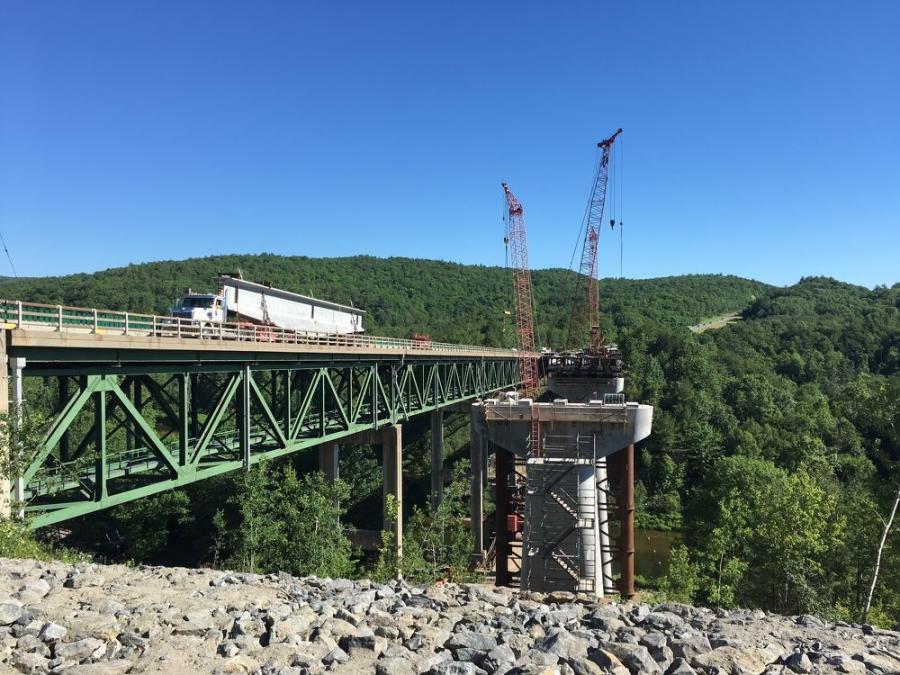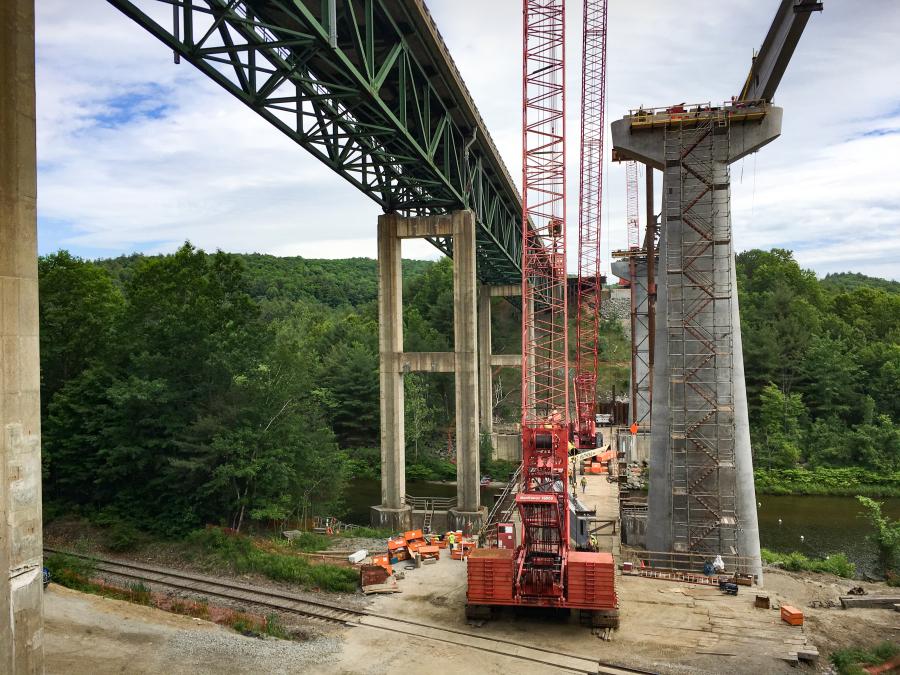Each concrete precast segment had to be taken off delivery trucks from the existing bridge.
When the Vermont Agency of Transportation (VTrans) replaced two aging bridges on I-91 in the town of Rockingham, spanning Green Mountain Railroad track and the Williams River, it did so with precast spliced girder bridges.
Reed & Reed Inc. delivered the $44.3 million design-build project this past September, having been given Notice to Proceed in July 2016 and authorized to design and construct in February 2017. The bridge is located in southeastern Vermont in the heart of the Green Mountains.
"The interstate crosses a moderate ravine in Rockingham," according to VTrans. "The precast spliced girder bridges exceeded the 100-year service life requirement of the bridges and are the first bridges of this type in Vermont. The design provided an economical solution for this important transportation link: an all-concrete structure that incorporates pre-stressing, post-tensioning and a blend of reinforcing materials, allowing local suppliers to provide the necessary materials and providing the required 100-year service life, in an aggressive de-icing environment."
The new bridges, the longest spliced precast girder bridges in the state, were built on the same site as the old 736-ft.-long, nearly 35-ft.-wide twin steel truss bridges constructed in 1965. The work site was located atop a challenging topography that is 130 ft. above an environmentally critical river.
"Though the bridges were rehabilitated in 1989 to provide additional structural life, they continued to deteriorate," VTrans told CEG. "Also, the bridge widths did not meet the current standards. They were considered fracture critical bridges and did not load rate well. Planning began in 2013 when a scoping report was completed with alternatives and a decision to replace the structure with a new bridge was deemed the best solution."
This is a crucial highway for the Green Mountain State.
"I-91 links Massachusetts to the Canadian border and it is critical that its condition can serve the travelling public as they commute to work, vacation, truck goods and services to our state and beyond," said VTrans. "It also links with I-89 and several state highways that cross the Connecticut River that serves the residents of New Hampshire. The Rockingham bridges needed to be replaced in order to maintain our network and ensure that travelling on our interstate is safe and efficient."
Many local dignitaries noted "the positive economic benefit of a project this size in a small community. The infrastructure is improved, and the local economy is stimulated by the influx of people living and spending money in the community."
To match the existing interstate corridor, each bridge has two 12-ft.-wide travel lanes, one 10-ft. breakdown shoulder and one 4-ft. median shoulder. Each new bridge is more than 41 ft. wide and 18 percent wider (more than 6 ft.) than the previous bridges and spans 860 ft. from abutment to abutment, which is 110 ft. longer than the previous bridges. HDR Inc. designed the bridges.
Until the replacement, the old bridges were open to traffic. The old bridges were demolished prior to the installment of the new ones.
"Each concrete precast segment had to be taken off delivery trucks from the existing bridge," said VTrans. "The contractor deployed a rolling roadblock that slowed interstate traffic to create a 20-minute window in which to connect and install the segment. The northbound bridge opened to traffic in April 2019, and the southbound bridge fully opened in September 2021. The public viewed the project with enthusiasm and wonder due to the size of the elements and the relatively low impact of the project on the daily lives of local residents and commuters."
Reed & Reed had to overcome many challenges to complete the project.
"The project was 100 feet plus off the ground," said John Phillips, R&R's project manager. "All the heavy lifts were done at a significant height with minimal clearance between the two bridges. Extensive construction engineering was performed to ensure the project was carried out safely. The work had to progress in a methodical process in order to maintain safety and efficiency. The design-build process allowed us to begin work while completing the design and planning as we progressed.
"We have built significant precast and segmental bridges in the past," he added. "This design was unique in that we had concrete girders with splices mid-span at a significant height with difficult access. Environmental concerns are always at the forefront of our work planning. We had to mitigate interference with a stream that ran through the primary access to the project."
Precast segments were fabricated by JP Carrara of Middlebury, Vt., which were done over a period of 17 months. The girders were nearly 200,000 lbs., and more than 100 ft. long.
"The concrete girders were fabricated with reinforcing steel, pre-tensioned strands and a post tensioning system that was installed on site," said Philips.
It took between six to eight hours for JP Carrara to transport the pieces it produced to the work site.
The northbound bridge was installed in April with the girder segments lifted and placed using a Manitowoc 16000 crawler crane and a model 999 Series.
"We erected the girders generally from north to south," said Philips. "The segments were lifted off trucks in approximately 20 minutes to allow highway traffic to resume. However, it took a matter of hours to get the girder set and fully secured."
The girders and other components were lifted mainly during the day.
"We also had miscellaneous support crane on site, as well as all-terrain forklifts and a boom truck," he said.
The demolition of the old bridges had crews pick off each span and cut up the steel trusses, which were sent for recycling.
"One challenge was lifting the spans off to the ground where they could be cut up," said Philips. "This required extensive construction engineering and planning."
A falsework system was installed to prevent any debris from falling into the river and onto the railway tracks.
Having installed one bridge, the crews were able to apply lessons learned for the southbound bridge.
"Pre-planning helped somewhat," said Philips, "but there are always unforeseen challenges on construction projects."
The management team included R&R's management and supervision and HDR's design professionals.
"The design-build team worked continuously as a team to deliver this project safely and with the highest quality," said Phillips. "The crews worked tirelessly and were dedicated."
R&R had other standard pieces of equipment on site.
"We had onsite mechanics at times primarily if equipment problems had the potential to cause safety or other impacts to travelling public," said Philips. "During winter, we were constantly having to deal with road salt and sand falling from the highway overhead. This created corrosion issues that had to be monitored." CEG
Irwin Rapoport
A journalist who started his career at a weekly community newspaper, Irwin Rapoport has written about construction and architecture for more than 15 years, as well as a variety of other subjects, such as recycling, environmental issues, business supply chains, property development, pulp and paper, agriculture, solar power and energy, and education. Getting the story right and illustrating the hard work and professionalism that goes into completing road, bridge, and building projects is important to him. A key element of his construction articles is to provide readers with an opportunity to see how general contractors and departments of transportation complete their projects and address challenges so that lessons learned can be shared with a wider audience.
Rapoport has a BA in History and a Minor in Political Science from Concordia University. His hobbies include hiking, birding, cycling, reading, going to concerts and plays, hanging out with friends and family, and architecture. He is keen to one day write an MA thesis on military and economic planning by the Great Powers prior to the start of the First World War.
Read more from Irwin Rapoport here.
Today's top stories





















